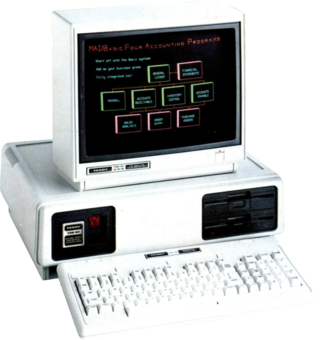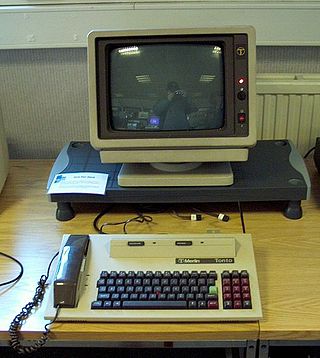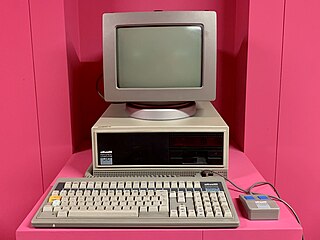Related Research Articles

The IBM Personal Computer is the first microcomputer released in the IBM PC model line and the basis for the IBM PC compatible de facto standard. Released on August 12, 1981, it was created by a team of engineers and designers directed by William C. Lowe and Philip Don Estridge in Boca Raton, Florida.

Amstrad was a British consumer electronics company, founded in 1968 by Alan Sugar. During the 1980s, the company was known for its home computers beginning with the Amstrad CPC and later also the ZX Spectrum range after the Sinclair deal, which led it to have a substantial share of the PC market in Britain. In the following decade it shifted focus towards communication technologies, and its main business during the 2000s was the manufacture of satellite television set-top boxes for Sky, which Amstrad had started in 1989 as the then sole supplier of the emerging Sky TV service.

The Tandy 1000 is the first in a line of IBM PC compatible home computer systems produced by the Tandy Corporation for sale in its Radio Shack and Radio Shack Computer Center chains of stores. Introduced in 1984, the product line was aimed at providing affordable but capable systems for home computing or education, with some of its Tandy specific features like graphics, sound and joystick port making it more appealing for home use.

The Personal System/2 or PS/2 is IBM's second generation of personal computers. Released in 1987, it officially replaced the IBM PC, XT, AT, and PC Convertible in IBM's lineup. Many of the PS/2's innovations, such as the 16550 UART, 1440 KB 3.5-inch floppy disk format, 72-pin SIMMs, the PS/2 port, and the VGA video standard, went on to become standards in the broader PC market.

The Tandy 2000 is a personal computer introduced by Radio Shack in September 1983 based on the 8 MHz Intel 80186 microprocessor running MS-DOS. By comparison, the IBM PC XT used the older 4.77 MHz Intel 8088 processor, and the IBM PC/AT would later use the newer 6 MHz Intel 80286. Due to the 16-bit data bus and more efficient instruction decoding of the 80186, the Tandy 2000 ran significantly faster than other PC compatibles, and slightly faster than the PC AT. The Tandy 2000 was the company's first computer built around an Intel x86 series microprocessor; previous models used the Zilog Z80 and Motorola 6809 CPUs.

In DOS memory management, conventional memory, also called base memory, is the first 640 kilobytes of the memory on IBM PC or compatible systems. It is the read-write memory directly addressable by the processor for use by the operating system and application programs. As memory prices rapidly declined, this design decision became a limitation in the use of large memory capacities until the introduction of operating systems and processors that made it irrelevant.

The Amstrad PC1512 was Amstrad's mostly IBM PC-compatible computer system, first manufactured in 1986. Next year a slight updated version named PC1640 was introduced. It was also marketed as PC6400, and Sinclair PC500. Schneider branded machines for the German market also exists.

The PC-9800 series, commonly shortened to PC-98 or 98, is a lineup of Japanese 16-bit and 32-bit personal computers manufactured by NEC from 1982 to 2000. The platform established NEC's dominance in the Japanese personal computer market, and, by 1999, more than 18 million units had been sold. While NEC did not market these specific machines in the West, it sold the NEC APC series, which had similar hardware to early PC-98 models.

The One Per Desk, or OPD, was an innovative hybrid personal computer/telecommunications terminal based on the hardware of the Sinclair QL. The One Per Desk was built by International Computers Limited (ICL) and launched in the United Kingdom in 1984. It was the result of a collaborative project between ICL, Sinclair Research and British Telecom begun in 1983, originally intended to incorporate Sinclair's flat-screen CRT technology.
The Mac286 was an Intel 80286-based MS-DOS coprocessor expansion card for one of Apple Computer's first expandable Macintosh computers, the 1987 Macintosh II. It was developed by Phoenix Technologies under contract to Apple Computer and sold by AST Research in an effort to close the gap between the Macintosh and IBM PC computing worlds. AST also introduced the related Mac86 card for the Macintosh SE.

The AT&T UNIX PC is a Unix desktop computer originally developed by Convergent Technologies, and marketed by AT&T Information Systems in the mid- to late-1980s. The system was codenamed "Safari 4" and is also known as the PC 7300, and often dubbed the "3B1". Despite the latter name, the system had little in common with AT&T's line of 3B series computers. The system was tailored for use as a productivity tool in office environments and as an electronic communication center.

The UltraLite was an IBM PC-compatible laptop released by NEC in October 1988. It was released alongside the heavier and more-capable ProSpeed. The UltraLite was based on the NEC V30 microprocessor; the computer includes MS-DOS 3.3 built into ROM.

The IBM JX was a personal computer released in 1984 into the Japanese, Australian and New Zealand markets. Designed in Japan, it was based on the technology of the IBM PCjr and was designated the IBM 5511. It was targeted in the Australasian market towards the public education sector rather than at consumers, and was sold in three levels: JX (64 KiB), JX2 (128 KiB) and JX3 (256 KiB). Upgrades were available to both 384 KiB and 512 KiB. The JX was the first IBM PC to use 3.5" floppy drives.

The Olivetti M19 was a personal computer made in 1986 by the Italian company Olivetti. It has an 8088 at 4.77 or 8 MHz and 256–640 KB of RAM. The BIOS is Revision Diagnostics 3.71. In the UK, it was sold by Acorn Computers as the Acorn M19, with additional software also available via Acorn. In France, it was available as the Persona 1300, sold by LogAbax.

The Olivetti M24 is a computer that was sold by Olivetti in 1983 using the Intel 8086 CPU.

The APC was a series of business microcomputers released outside of Japan by the NEC Corporation. The series comprised the APC, the APC II and APC III, international versions of models from the Japanese NEC N5200 series(jp).
The ICL DRS was a range of departmental computers from International Computers Limited (ICL). Standing originally for Distributed Resource System, the full name was later dropped in favour of the abbreviation.

The IBM Personal Computer XT is the second computer in the IBM Personal Computer line, released on March 8, 1983. Except for the addition of a built-in hard drive and extra expansion slots, it is very similar to the original IBM PC model 5150 from 1981.

The West PC-800 was a home computer introduced by Norwegian company West Computer AS in 1984. The computer was designed as an alarm center allowing use of several CPUs and operating systems. The company introduced an IBM PC compatible in early 1986 and the West PC-800 line was phased out.

The Personal System/2 Model 30 and Personal System/2 Model 30 286 are IBM's entry-level desktop computers in their Personal System/2 (PS/2) family of personal computers. As opposed to higher-end entries in the PS/2 line which use Micro Channel bus architecture, the Model 30 features an Industry Standard Architecture bus, allowing it to use expansion cards from its direct predecessors, the PC/XT and the PC/AT. The original PS/2 Model 30 is built upon the Intel 8086 microprocessor clocked at 8 MHz; the Model 30 286 features the Intel 80286 clocked at 10 MHz.
References
- ↑ "M4000 Merlin". www.old-computers.com. Retrieved 18 March 2023.
- ↑ "Merlin M4000 read more". OLD-COMPUTERS.COM : The Museum. Retrieved 18 March 2023.
- ↑ BT Brochure - TEMPEST, System Solutions from British Telecom
- ↑ "Micros for the Navy". British Telecom Journal. Vol. 7, no. 4. January 1987. p. 83. Retrieved 12 January 2021.
- ↑ "GAP in the marketplace". British Telecom Journal. Vol. 8, no. 3. October 1987. pp. 41–44. Retrieved 12 January 2021.
- ↑ "Merlin micro boom". British Telecom Journal. Vol. 6, no. 1. April 1985. p. 43. Retrieved 11 January 2021.
- ↑ "Computerisation (Hansard, 5 December 1988)". 17 January 2018. Retrieved 18 March 2023.
- ↑ BT Brochure - TEMPEST, System Solutions from British Telecom
